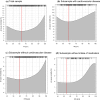Heart rate, mortality, and the relation with clinical and subclinical cardiovascular diseases: results from the Gutenberg Health Study
- PMID: 30953178
- PMCID: PMC6868108
- DOI: 10.1007/s00392-019-01466-2
Heart rate, mortality, and the relation with clinical and subclinical cardiovascular diseases: results from the Gutenberg Health Study
Abstract
Background: Higher, but also lower resting heart rate (HR), has been associated with increased cardiovascular events and mortality. Little is known about the interplay between HR, cardiovascular risk factors, concomitant diseases, vascular (endothelial) function, neurohormonal biomarkers, and all-cause mortality in the general population. Thus, we aimed to investigate these relationships in a population-based cohort.
Methods: 15,010 individuals (aged 35-74 at enrolment in 2007-2012) from the Gutenberg Health Study were analyzed. Multivariable regression modeling was used to assess the relation between the variables and conditional density plots were generated for cardiovascular risk factors, diseases, and mortality to show their dependence on HR.
Results: There were 714 deaths in the total sample at 7.67 ± 1.68 years of follow-up. The prevalence of diabetes mellitus, arterial hypertension, coronary and peripheral artery disease, chronic heart failure, and previous myocardial infarction exhibited a J-shaped association with HR. Mortality showed a similar relation with a nadir of 64 beats per minute (bpm) in the total sample. Each 10 bpm HR reduction in HR < 64 subjects was independently associated with increased mortality (Hazard Ratio 1.36; 95% confidence interval 1.06-1.75). This increased risk was also present in HR > 64 subjects (Hazard Ratio 1.29; 95% confidence interval 1.19-1.41 per 10 bpm increase in HR). Results found for vascular and neurohormonal biomarkers exhibited a differential picture in subjects with a HR below and above the nadir.
Discussion: These results indicate that in addition to a higher HR, a lower HR is associated with increased mortality.
Keywords: Heart rate; Mortality; Neurohumoral biomarkers; Population-based; Vascular (endothelial) function.
Conflict of interest statement
The authors declare that they have no conflict of interest.
Figures


Similar articles
-
Resting heart rate is an independent predictor of all-cause mortality in the middle aged general population.Clin Res Cardiol. 2016 Jul;105(7):601-12. doi: 10.1007/s00392-015-0956-7. Epub 2016 Jan 23. Clin Res Cardiol. 2016. PMID: 26803646
-
Resting heart rate, temporal changes in resting heart rate, and overall and cause-specific mortality.Heart. 2018 Jul;104(13):1076-1085. doi: 10.1136/heartjnl-2017-312251. Epub 2017 Dec 21. Heart. 2018. PMID: 29269380
-
Clinically recorded heart rate and incidence of 12 coronary, cardiac, cerebrovascular and peripheral arterial diseases in 233,970 men and women: A linked electronic health record study.Eur J Prev Cardiol. 2018 Sep;25(14):1485-1495. doi: 10.1177/2047487318785228. Epub 2018 Jul 2. Eur J Prev Cardiol. 2018. PMID: 29966429
-
Resting heart rate and measures of effort-related cardiac autonomic dysfunction predict cardiovascular events in asymptomatic type 2 diabetes.Eur J Prev Cardiol. 2016 Aug;23(12):1298-306. doi: 10.1177/2047487315624747. Epub 2015 Dec 23. Eur J Prev Cardiol. 2016. PMID: 26701872 Clinical Trial.
-
Heart Rate Recovery and Risk of Cardiovascular Events and All-Cause Mortality: A Meta-Analysis of Prospective Cohort Studies.J Am Heart Assoc. 2017 May 9;6(5):e005505. doi: 10.1161/JAHA.117.005505. J Am Heart Assoc. 2017. PMID: 28487388 Free PMC article. Review.
Cited by
-
A Dual-Modality Home-Based Cardiac Rehabilitation Program for Adults With Cardiovascular Disease: Single-Arm Remote Clinical Trial.JMIR Mhealth Uhealth. 2024 Oct 1;12:e59098. doi: 10.2196/59098. JMIR Mhealth Uhealth. 2024. PMID: 39150858 Free PMC article. Clinical Trial.
-
Prognostic Significance and Associations of Neural Network-Derived Electrocardiographic Features.Circ Cardiovasc Qual Outcomes. 2024 Dec;17(12):e010602. doi: 10.1161/CIRCOUTCOMES.123.010602. Epub 2024 Nov 14. Circ Cardiovasc Qual Outcomes. 2024. PMID: 39540287 Free PMC article.
-
ARNIs: balancing "the good and the bad" of neuroendocrine response to HF.Clin Res Cardiol. 2020 May;109(5):599-610. doi: 10.1007/s00392-019-01547-2. Epub 2019 Sep 17. Clin Res Cardiol. 2020. PMID: 31531687
-
Initial in-hospital heart rate is associated with long-term survival in patients with acute ischemic stroke.Clin Res Cardiol. 2022 Jun;111(6):651-662. doi: 10.1007/s00392-021-01953-5. Epub 2021 Oct 23. Clin Res Cardiol. 2022. PMID: 34687320 Free PMC article.
-
Cryoballoon pulmonary vein isolation-mediated rise of sinus rate in patients with paroxysmal atrial fibrillation.Clin Res Cardiol. 2021 Jan;110(1):124-135. doi: 10.1007/s00392-020-01659-0. Epub 2020 May 13. Clin Res Cardiol. 2021. PMID: 32405738 Free PMC article.
References
-
- Fox K, Ford I, Steg PG, Tendera M, Robertson M, Ferrari R, investigators B. Heart rate as a prognostic risk factor in patients with coronary artery disease and left-ventricular systolic dysfunction (BEAUTIFUL): a subgroup analysis of a randomised controlled trial. Lancet. 2008;372(9641):817–821. doi: 10.1016/S0140-6736(08)61171-X. - DOI - PubMed
-
- Bohm M, Swedberg K, Komajda M, Borer JS, Ford I, Dubost-Brama A, Lerebours G, Tavazzi L, Investigators S. Heart rate as a risk factor in chronic heart failure (SHIFT): the association between heart rate and outcomes in a randomised placebo-controlled trial. Lancet. 2010;376(9744):886–894. doi: 10.1016/S0140-6736(10)61259-7. - DOI - PubMed
-
- Tardif JC, Ponikowski P, Kahan T, Investigators AS. Efficacy of the I(f) current inhibitor ivabradine in patients with chronic stable angina receiving beta-blocker therapy: a 4-month, randomized, placebo-controlled trial. Eur Heart J. 2009;30(5):540–548. doi: 10.1093/eurheartj/ehn571. - DOI - PMC - PubMed
MeSH terms
Grants and funding
LinkOut - more resources
Full Text Sources

